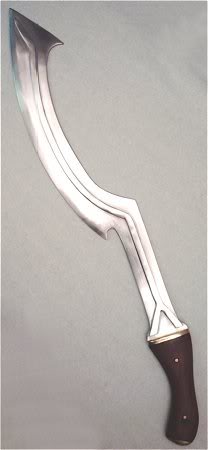

This weapon has no place in medieval warfare,
for
it is an Egyptian
weapon which went out of use around the tenth century
B.C. However, it
is so interesting and it fits so well into the concepts
of the game that it can be added if the
DM approves of such. A
khopesh has about six inches of handle
&& quillons. Its blade is then
straight from the quillons for about two
feet. The blade becomes
sickle-shaped at this point, being about
two additional feet long but effectively
extending the overall length of the sword
by only 11/2 feet.
The curved portion resembles a squared-off
capital letter “D,” complete
with upper serif, but with the back (left-hand)
bar missing. This
makes the khopesh both heavy and unwieldy
(thus the high number
for speed factor), difficult to employ
properly and undoubtedly hideously
difficult and slow to recover, particularly
after a badly missed
blow. Nevertheless, the weapon will not
only cause damage, but its
sickle-like portion can snag an opponent
or an opposing weapon. Unless
the opponent is 50% smaller and lighter
than the wielder of the
khopesh (deducting or adding 5% per point
or category over 18 of
strength difference to arrive at final
mass), the weapon will simply
make it impossible for the snagged opponent
to get in an effective attack
for 10 segments. If smaller and lighter,
the opponent will either be
pulled to the ground (25%) or impeded
in an attack (75%) when
snagged.
A weapon can be snagged only if it has
protrusions or indentations,
but the only smooth weapons for this purpose
are daggers, swords,
spears, and the like. Just as with snagging
an opponent where any hit
has a 5% chance to do so, any miss also
allows a 5% chance for
snagging the opponent’s weapon, if applicable.
If an opponent’s
weapon is snagged, there is a 10% chance
it will be torn from his or
her grasp. Failing that, the snagging
will either disallow the opponent
the opportunity to effectively attack
for 10 segments (80°/o), just as a
bodylequipment snag would, or else the
opponent’s strength andlor
leverage would tear the wielder’s grasp
(10%).
Because of this weapon’s ancient origin
and unusual shape, it is an
ideal druidical instrument. The DM should
consider placement of
both normal and magical khopeshes in the
campaign, aiming especially
at druidical use. Of all magical scimitars
discovered, 10% will
be khopeshes.
| Weapon Type | Approximate
Weight in Pounds |
Size S or M | Size S or L | Weapon Type | Length | Space
Required |
Speed
Factor |
0 | 1 | 2 | 3 | 4 | 5 | 6 | 7 | 8 | 9 | 10 |
| Khopesh | 7.5 | 2-8 | 1-6 | Khopesh | c. 31/2' | 4' | 9 | -7 | -6 | -5 | -4 | -2 | -1 | 0 | 0 | +1 | +1 | +2 |